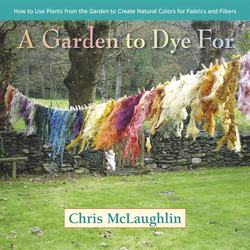Читать книгу A Garden to Dye For - Chris McLaughlin - Страница 11
На сайте Литреса книга снята с продажи.
One Another Good Reason for Your Plant Addiction
ОглавлениеJust in case you needed a new excuse to peruse, purchase and obsess over plants – you’ve come to the right place. Let me introduce you to the world of borrowing color from your garden!
Fair warning, though: once you start dyeing it’s surprisingly hard to stop. Forever after, you’ll be looking at everything around you in one of two ways. The next plant you lay eyes on, one of your first thoughts will be “Hmmm . . . can I get color out of that?” Anytime you see fabric or fiber, you’ll think, “I wonder if that will take color?”
To you, dear gardener, I just want to say “Sorry ‘bout that” and “Welcome to your new addiction.”
It’s probably best to start from the beginning. My attraction to plants began when I was about ten years old and discovered tiny seedlings (volunteers) growing willy-nilly in our traditionally landscaped backyard. I promptly dug them up and placed them into bathroom-sized Dixie cups along with some fresh, bagged soil.
Lining them up carefully in my little brother’s red wagon, I wheeled them behind me going door-to-door peddling them for 10 cents apiece. Not only did our unsuspecting neighbors witness a budding entrepreneurial spirit, but a gardener was born as well.
By that time it was already too late for me. Pandora’s box had been opened and my obsession continued to thrive in various ways; flowers, vegetables, houseplants, and herbs each had a turn and all of them had my devout attention. Every time I discovered a new way to use plants in my daily life, I had a tendency to throw myself headfirst into the topic.
About twenty years ago, an interesting (and beautiful) article caught my eye. It described how one could derive color from plants found in any average garden. It included directions for dyeing Easter eggs. I was transfixed. Until that day, I had only played around with pounding random flowers and leaves in order to transfer their color – I didn’t have any official instructions on utilizing plant colors except for a couple of articles I’d run across here and there. I certainly didn’t realize that the dyes could be permanent. I would find that out much later (to my delight) as I was an avid sewer, as well.
Years passed. Along with my insatiable need for plants and fabric, I decided that I should broaden my world and learn to knit. Funny thing happened on my way to knitting class: I thought too hard about the yarn. I needed to know where it came from and how it was made. In an embarrassingly short amount of time, I became completely smitten with fiber – all kinds, every kind. I fell mostly for animal fibers such as wool (sheep), mohair (goat), and angora (rabbit).
And then I did what comes naturally when one has an all-encompassing love affair with wool and the like: I learned to handspin. Yes, I mean all the stuff of Rumpelstiltskin. I got hold of as many different fibers as I could find in order to get a feel for different fibers slipping through my hands and being pulled onto the wheel that magically transformed it into yarn. I already kept Angora rabbits, but things really got humming when I was given an Angora goat for Christmas.
And colors . . . oh, the colors. The urge to create hues of my own – this time for my fiber – resurfaced. Who better to turn to than my beloved plants?
